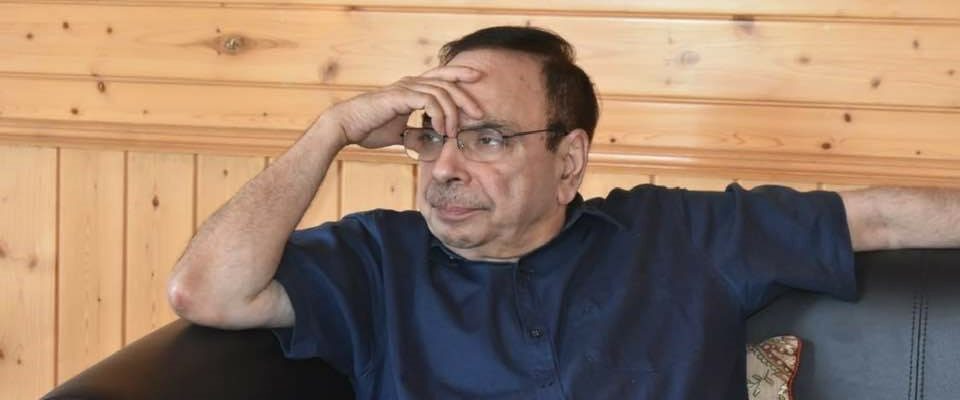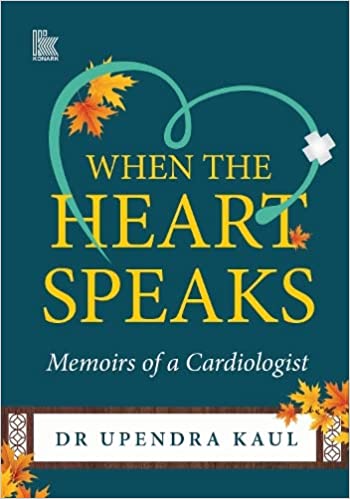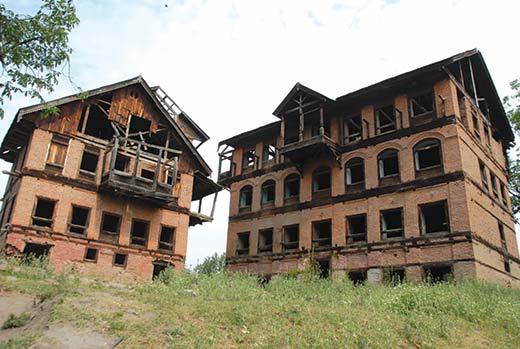Kashmir’s leading cardiologist, Dr U Kaul’s book offers interesting anecdotes about the evolution of better heart care and various heart-breaking events, writes Khalid Bashir Gura
After completing his MBBS, when Dr Upendra Kaul, was filling out his documents to go abroad for higher studies, he stopped midway after seeing his mother’s moist eyes.
“Amma asked me what I was doing so seriously,” Dr Kaul, Kashmir’s first cardiologist, now a Padma Shri, narrates in his lucid, engaging, entertaining and informative memoir When the Heart Speaks. “I told her the truth. She remained silent for a while with moist eyes. She told me after all their hard work in making me a doctor; I too had some responsibility towards them. I got the point and immediately tore away those forms, which brought a smile to her face.”The book, published by Konark Publishers is an un-put-downable 190-page read making a
reader traverse through a cardiologist’s heart. The story spools from his ancestral Hawl village in Shopian to the life he spent in Delhi and finally back home.
Born on June 14, 1948, the family moved out of Kashmir when he was 18 months old. The yearning to return always persisted. He did but with the mission to heal hearts.
The book displays his extraordinary memory as he recalls minute details chronologically laced with confessions, forthrightness, and his ability to recall many public events including the history of places and people. Kaul has skilfully operated his memoir not to become a work of self-indulgence by underpinning it with various characters in his life which in turn shaped his life.
Plain Speak
His love for Kashmir and its people runs reciprocal. He helped his people wherever, whenever. Despite the ill feeling of Kashmir Pandits (KP) toward Muslims after the 1990s, according to the author, his affection for the Kashmiri people never changed. In When the Heart Speaks, Kaul’s heart continues to beat for Kashmir and his heartbeat is palpable in his mission of Gauri Kaul Foundation. He blurs the blood-drenched boundaries between religions and communities. He pumps love, friendship and peaceful co-existence by making the heart of humanity throb through his on-ground contribution.

While tracing the history cursorily of his community from the fourteenth century, which according to him is replete with oppression, death and destruction under various Muslim rulers, he also gives a brief idea to mention the plight of the downtrodden majority community also.
Introduction
The author introduces the book through the dissimilarity in village and city life through his parents who grew up in completely diverse environments and dissimilar upbringings. His father was born in Hawl, Shopian in a picturesque village while his mother was born in Sopore but brought up in Srinagar. Besides the beauty of his land, he vividly remembers the intricacies of his ancestral house and its architecture, which like many others is a heritage and abandoned house now.
Besides introducing to grandparents, parents and the times they lived in, he sketches the societal, cultural, and economic contour of the society of his times also vividly.
The Village
The Muslim minority in his village worked as artisans or landless agricultural peasants or servants on Pandit’s lands. According to him, the Pandits considered themselves superior and pious to the majority of Muslims. Similarly, as his father had to travel 20 km daily to school, he was forbidden to buy bread from Muslim bakers as he belonged to high caste Brahmins.
As his father went on to pursue education, he regrets his mother’s unfulfilled desire for the same as she was prevented from getting an education because of her gender. He also stands witness to his mother’s aversion to village life and the difficulties it entailed. His father who was encouraged to get educated earned a bachelor’s in law at Lucknow while as his mother had little formal education as it was not encouraged during her time. He also explains the genesis of his surname from Khans to Kauls.

When the author was 18 months old he was brought to Delhi. Terming himself to be a shy child who could barely make friends, he grew up under strict parental control. He recalls getting thrashed by his father when he flunked his eighth standard because of his bunking school with a friend, which resulted in abysmal neglect of his studies. That year as a punishment he was left in the sweltering heat of Delhi much to his aversion and not allowed to visit Kashmir for which he waited every year eagerly. The school failure didn’t decide the future.
As he invokes the details of each person, place, incident, and a slice of ‘collective’ and personal history, his teachers, and friends since childhood are no exception. Similarly, his experiences of growing up far away from his birthplace are filled with intricate details and his interactions with people from diverse walks of life. He always looked forward to summer vacations and visiting Kashmir and playing on the banks of river Jhelum with neighbouring children. “Those were the days when the valley didn’t start distinguishing between religions and as children, we never knew who was a Hindu or Muslim or belonged to which caste,” he writes. His cousins, the carefree atmosphere and the river with my childhood friends enticed him much more than Delhi life.
In Medical School
As he excelled academically, he secured admission for an MBBS. But his new busy schedule could not tether him and soon his fast friends were Kashmiris chosen for the MBBS course in his college. He soon started learning his mother tongue far away from home as he was deprived of it and began visiting home with his Kashmiri friends every year religiously.
The chapter Medical College Years is replete with his experiences in medical college like any other medical student but he fills it with information and analysis once he encounters Hindu places of historic importance during his annual visits to Kashmir. His life as a junior resident doctor resident analyses the limitations, he faced in the health care set-up. A reader may be surprised when Dr Kaul confesses he had tasted charas opium and after a few months given it up. Thankfully, as it didn’t become a habit, the reader will hope no one idolizing doctor will try it. Wonder why the author didn’t self-censor it for the collective good?
The 1971 War
It was also the time when Bangladesh was liberated in 1971. He recalls the war build-up and mock drills and sirens in Delhi as there were apprehensions Pakistan will bomb the city. Besides, getting into the mundane details of his colleagues, he also recollects many public events of Kashmir, the first being the theft of a holy relic in December 1963.
Unlike today, as he was selected in post-graduation on the basis of his MBBS merit, he reveals that flattery often worked in getting the guides, especially HODs. He expresses his inability to flatter as well as having connections like other blue-eyed candidates. He fitted in none, despite his maternal uncle being the principal secretary of Mrs Indira Gandhi as his parents underscored that one should deserve achievement based on merit. He landed up in pulmonology but the abysmal state of the lab led the doctor to explore other options for specialization and change of place. After discussing it with his colleagues, he found a vacancy in cardiology at GB Pant Hospital and he assessed its cost-benefit ratio. He landed up in an institute, which had better infrastructural facilities as the hospital had a modern coronary care unit (CCU) to manage patients with heart attacks.
This was possibly the first CCU in India according to the author as the history of CCU dates back to 1964. The author, when looking back feels proud to be associated with CCU care in its early days in India. As he describes his stressful life as a junior resident, he recalls experiences encountered in this phase of life.
The Marriage
In July 1975, during his first year of DM training, her got married to a fellow doctor, Dr Upkar who was older than him by four years. Her parents were Sikhs from Peshawar who had migrated to Meerut. But according to the author, the love knows no logic and is much against his family’s wish he married her.
Due to shortcomings in GB Panth Hospital as its cardiac surgery department was not active, the doctor had to travel to Vellore in south India. He soon registers the stark differences in culture, language and way of life in North and South and explores India’s diversity. However, his impressions of the people of the south were that they were simple, not flashy and hard working. Soon he began to travel to Kerala and Bangalore.
Cold Shouldered
After becoming a cardiologist, uncertainty taught the author many lessons like not to depend on guides and friends who wished him well but could not do much. He narrates his disillusioned encounter with Sheikh Abdullah, the patron of SKIMS who turned a cold shoulder to the doctor’s request to serve at SKIMS. Finally, he joined the Postgraduate Institute of Medical Institution (PGIMER) in 1979 as an assistant professor. The doctor narrates his new life at Chandigarh, his yearning to return to family and finally managing an ad hoc lecturer at GB Pant hospital in 1980. But the working culture let him down.
In 1981, he joined AIIMS after not being able to make it in the first attempt as an interviewer who had a poor opinion of people who were not trained at AIIMS. However, the next time when he was appointed there were changes in rules and reforms were initiated. The author documents his experiences in the hospital and his out-of-box thinking solutions in the cardiology department.
A Flight Abroad
In 1983, he availed a three-month fellowship to visit Australia. As this was his first visit outside India, he recalls the thrill with the same enthusiasm. He soon realized the stark differences between the hospitals of his host country and his home country and how the medical services were far behind in India. A realization dawned on him also when he analysed how doctors and paramedics were relaxed in Australia unlike overburdened and stressed at home. This problem persists as the doctor-patient ratio continues to be a problem in the health care sector he explores in his book. Besides many clinical insights he developed, Kaul also learned about coronary angioplasty and associated patient care and how the practice of medicine can be enjoyable and gratifying. He recalls many Kashmiri acquaintances in the country excelling in other walks of life. After his brief but useful professional and social experience in a developed country, he felt contributing to his department from his new experiences.
After his return from Australia, as wanted to display his newly learnt skills and he started coronary angioplasty in India. In the process, he soon got multiple invitations to visit Tokyo. The doctor traces the evolution of coronary angioplasty in India and his team’s contributions.
During one of his training courses, in the USA, he recalls meeting affluent Dr Fayaz Shawl, a cardiologist originally from Kashmir. Dr Shawl, he recalls had told him that he had taken cases rejected for angioplasty because of being very complex and even some surgical procedures like percutaneous cardiopulmonary support ( PCPS) were named Shawl Kit which he helped design and was manufactured by him.
The limitations of balloon angioplasty were circumvented by the use of metal meshes called stents by early 1990. As a part of pacemaker’s industry-sponsored meeting in 1993 in London, the author recalls his racist encounter in the country and the humiliations it entailed. His notion of being a fair-skinned Kashmiri was dented.
The Dark Era
The author in the chapter a Dark Era in Kashmir Valley traces the causes of the ‘radicalization’ of peace-loving people and their growing revulsion with Sufi Islam. In order to create context, he also writes briefly about international events stoking Kashmir’s violent upheaval. The author, meanwhile, had to bear a long separation from his homeland from 1990 to 1997 and also witness the mass migration of his community. But according to him, the first exodus was in 1986 when many families from Anantnag fled to Jammu in response to Babri Masjid Ayodha, which was opened for Hindus to worship.
As things went haywire and the terror struck the community left the valley, he recalls, how he helped Kashmiris despite festering wounds. “I went out of my way to shorten their OPD appointments and get investigations done and sometimes with monetary help. By now a word had spread regarding my soft corner for Kashmiris,” he narrates. Whenever he visits his patients in Kashmir, he recalls the overwhelming generosity and hospitality unleashed even by the neighbours.
Invited Home
In 1995, Mufti Mohammad Sayeed who used to get the medical opinion of Dr Kaul, suggested he come to Srinagar at least once in a few months and see patients in fortified Gupkar. During one visit to the city, he found the alleys were unchanged. Even though people’s hearts were filled with love and relished the old days of harmony, they were pessimistic. They held Governor Jagmohan responsible for facilitating the exodus so that he can take ruthless action against the people. However, the author questions people’s silence at targeted killings which triggered fear in the first place.
As he could not visit Kashmir due to militancy, he sought an alternative to beat summer’s heat in Himachal Pradesh. But according to him, it turned out to be a poor match for Kashmir.

His visits to Pakistan and China were insightful too as he always had a keen desire to travel the neighbouring country. Besides his interactions with counterparts, his impressions were that people, culture, and food across the border share similarities. They are friendly and hospitable, he narrates through his encounters with different people. According to him, people-to-people contact should be encouraged as they are sandwiched in power politics. Regarding China, he documents the rapid alleviation of poverty in the country and the enhanced hospitals and healthcare facilities.
In his book, he also mentions being blessed by Sathya Sai Baba and his philanthropic contribution to health care. However, the author’s critical mind was not at rest regarding god man’s miracles.
The Exit
The author also documents his painful exit from AIIMS because of varied reasons from low salary to recruitment racket. He recalls how another candidate was favoured due to political backing. Finally, due to family compulsions, he had to leave the government sector and join a private hospital.
The author also narrates his experience in private hospitals and the corporatization of healthcare with integrity. He details how gullible are fleeced and the nexus of various stakeholders in the murky sector have made healthcare a money-minting business with an aim of profit over people. He also mentions the unethical medical research being done in some centres in the country and how culprits evade accountability. He also abhors the kickback or referral system and narrates his experience as he witnessed malpractice by doctors. “I know from personal experience that patients were being charged for coronary stents when no stent was implanted,” he writes in his memoir.
Gauri Manzil
The author finally found closure to his dreams when he got Gauri Manzil constructed as he named the house after his mother who always yearned to return back to his homeland. And it was there on one fine evening that the author along with friends decided to visit far-off villages to provide health care. Soon a project was born Gauri Healthy Heart Project was started on September 29, 2020, which coincided with World Heart Day.
In the middle of the book, the author enhances the value of the story through visuals from his life with people from diverse walks of life projecting his learning and achievement trajectory.
Even though the author has repeatedly narrated that he was taking care of the hearts of almost all Kashmiri separatists as a cardiologist, the book, however, does not even make a passing reference to that.















